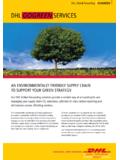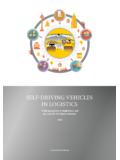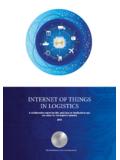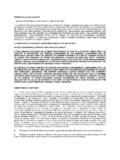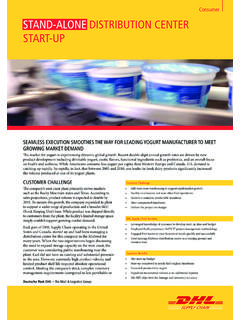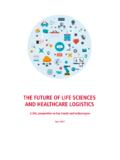Transcription of KEY LOGISTICS TRENDS IN LIFE SCIENCES 2020 - …
1 KEY LOGISTICS TRENDS IN life SCIENCES 2020+A DHL perspective on how to prepare for future growthPowered by Solutions & Innovation: Trend Research Preface 3 Introduction and Executive Summary 41. Megatrends 62. Challenges for the life SCIENCES Sector Shifting Disease Patterns Better-informed Patients New Health Markets Growing Competition Increasing Cost Pressure Outsourcing and More Complex Supply Chains More Stringent Regulation Innovation 163. LOGISTICS Implications and Required Actions Differentiating Supply Chains Empowering the Consumer Building Up Local Capabilities Increasing Supply-chain Transparency and Visibility Maintaining Supply-chain Adaptability 21 Sources 23 For More Information 272 Table of ContentsDear Reader, We live in a world of 24-hour news coverage with the internet, TV, radio, newspapers and magazines all vying for our attention across multiple devices.
2 For business leaders, there s an intense pressure to be constantly connected to information channels and always keep up-to-date with the latest business headlines, viewpoints and abundance of opinion and plethora of must-read stories can be bewildering. It can cloud the real issues and leave the practitioner unaware of and disoriented regarding key opportu-nities and challenges of the this white paper, DHL seeks to cut through the extraneous chatter and white noise. Our aim is to extract the key TRENDS for 2020 and beyond that are relevant to you LOGISTICS decision-makers with pharmaceutical and medical device manufacturers and thus provide suggestions for your focus, consideration and action. The structure of the white paper follows a three-stage approach: Collection and analysis of the most important megatrends Identification of the key challenges for the life SCIENCES sector resulting from these macro changes in society, technology, the economy, the environment and politics Deriving the respective LOGISTICS implications, pinpointing areas where action is requiredWe hope to provide a comprehensive repository of knowledge for our customers and part-ners.
3 Our aim is to stimulate collaborative discussion throughout our networks and alliances, resulting in new ideas, innovative projects and solutions, and creating value for all involved. This white paper benefited tremendously from cooperation with Z_punkt The Foresight Company, a leading foresight consultancy. We now invite you to peruse our view of the Key LOGISTICS TRENDS in life SCIENCES 2020+ . Please feel free to share it with your colleagues and peers, and don t hesitate to share your thoughts, observations and insights with faithfully,Dr. Markus K ckelhausDr. Michael Terhoeven3 PrefaceIntroduction and Executive SummaryOver the past decade the global life SCIENCES sector has experienced healthy growth. The world market for pharmaceuticals, for example, has doubled within a decade. It has reached a value of about USD 1 trillion and is expected to grow by another 3 to 6 per cent per annum until 2016 (IMS 2012a). Strong growth rates until 2020 are also forecast for the market for medical devices.
4 LOGISTICS has long been considered a basic support-ing function within the life SCIENCES sector. However, the importance of LOGISTICS is growing for a number of reasons: (1) the increasing relevance of emerging markets and globalization of supply chains, in turn (2) driving increasing regulatory efforts in particu-lar around temperature management and, finally, (3) a changing product portfolio that, on the one hand, allows new direct-to-market approaches notably for specialties and, on the other hand, requires differen-tiated value-focused approaches for value products and generics, where the cost of LOGISTICS drives a larger share of total white paper is intended to contribute to the endeavor of managing the resulting challenges. Its aim is to systematically identify the most important required actions for life SCIENCES logisticians for the coming years. Our key findings for life SCIENCES LOGISTICS include the following:1.
5 We expect a shift from undifferentiated LOGISTICS structures to more differentiated supply chains, with the mode of transportation, warehousing and depth of distribution tailored to different life SCIENCES product categories. 2. We believe that manufacturers in the life SCIENCES sector will build up direct-distribution channels to the end consumer. They will either develop their own e-commerce operations or distribute their products via third-party We see pharmaceutical and medical device manu-facturers expanding their capabilities to tier-2 and tier-3 cities and sometimes even to rural areas in emerging countries. However, there are likely to be differentiated approaches to depth of distribution and to implementation In future, we expect that better visibility in the supply chain will be required not only for product security and integrity, but also because of the need to control and optimize LOGISTICS processes (for example, with outsourcing and emergency LOGISTICS complementing slower-mode transpor-tation and demand-driven supply chains).
6 At the same time, visibility will enable differentiation and create value (for example, with direct-distribution models, mentioned in 2. above).5. Finally, we foresee the need for manufacturers in the life SCIENCES sector to keep supply chains flexible to adapt to new regulatory standards and the distribution requirements of innovative prod-ucts. We expect more temperature-differentiated supply-chain solutions, as well as infrastructures adaptable for product bundles and more personal-ized medicines and implants. gettyimages/Cultura Science/Rafe Swan4 Introduction and Executive SummaryFrom Megatrends to Challenges to LOGISTICS ImplicationsDemographic Changes and UrbanizationChangingCompetitiveLandscape ConsumerismTechnologicalProgressShifting Centers of Economic ActivityClimateChange andEnvironmen-tal Pollution1. MegatrendsNew Health MarketsMore Stringent RegulationShiftingDisease PatternsGrowing CompetitionInnovationBetter-informed PatientsOutsourcing and More Complex Supply ChainsIncreasing Cost Pressure2.
7 Challenges for the life SCIENCES SectorEmpowering the ConsumerBuilding Up Local CapabilitiesIncreasing Supply-chain Transparency and VisibilityMaintaining Supply-chain AdaptabilityDifferentiating Supply Chains3. LOGISTICS Implications and Required Actionsbold = exemplary impact route from megatrend to life SCIENCES logisticsOur approach follows three steps: As a first step, the most important megatrends in the environment of healthcare are briefly reviewed. In the second step, we identify the key challen-ges for the life SCIENCES sector resulting from these macro changes in society, technology, economy, environment and politics. For the third step, we extract the respective LOGISTICS implications and required 1 Step 2 Step 35 Introduction and Executive Summary1. MegatrendsMegatrends are long-term transformation processes with a broad scope and a potentially dramatic impact (Z_punkt 2012). They will shape the life SCIENCES sector as well as many other industries over the next few decades.
8 Demographic Changes and Urbanization can be considered the most influential megatrend. The global population is expected to increase from billion people in 2010 to billion in 2025, with growth found almost exclusively in developing countries. At the same time, the popula-tion in almost all countries is aging. The average age in Germany will rise from 44 in 2010 to 48 in 2025, while the median age in China will increase from 35 to 40 during the same period (UN 2010). This will be accompanied by a growing demand for health-care and a shift towards age-related disease patterns. Apart from population growth and aging, mankind will witness an unprecedented migration from rural to urban areas. By 2025, the share of people living in cities, globally, will have increased to 58 per cent from 52 per cent in 2010 (UN 2011). This shift will have direct consequences for healthcare infrastruc-tures and LOGISTICS . Cities are also the place for modern lifestyles, which are at the core of the Consumerism megatrend.
9 There is a global trend towards individualization, mean-ing that in almost all societies worldwide traditional relationships will decrease in importance, whereas individual choice and responsibility will grow. This will lead to rising health awareness and more dif-ferentiated demand for products in healthcare and life SCIENCES , as well as in other sectors. The consumerism trend in emerging economies will go hand in hand with global Shifting Centers of Economic Activity. This megatrend underlines that economic growth in the emerging world is much gettyimages Cyril Comtat Megatrendsproteomics, biomics) is expected to be impressive and will have an impact on healthcare treatments and products. On the other hand, economic growth is still associated with an increased burning of fossil fuels. This will lead to Climate Change and Environ-mental Pollution, primarily in fast-growing mega-cities facing new healthcare challenges.
10 Experts assume that globally urban air pollution is respon-sible for 1 million premature deaths and 1 million prenatal deaths each year (UNEP 2013).faster than in industrialized countries. From 2010 to 2030, GDP (gross domestic product) in Europe is expected to increase by 50 per cent, while GDP in the BRIC countries (Brazil, Russia, India, China) will rise by 190 per cent, almost tripling economic production (PwC 2011a). This megatrend will lead to rising incomes in the emerging world and rising export opportunities for life SCIENCES manufacturers. At the same time, we will see a Changing Competi-tive Landscape with pharmaceutical and medical device manufacturers, for example, from India and China, entering the global market. Economic growth is associated with several other megatrends. The first of which is Technological Progress, which, during the next decade, will still be characterized by increasing digitization. Driven by information technology, the progress in neu-rology (imaging) and biotechnology (genomics, gettyimages gettyimages71.)



